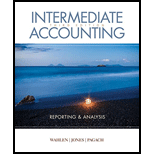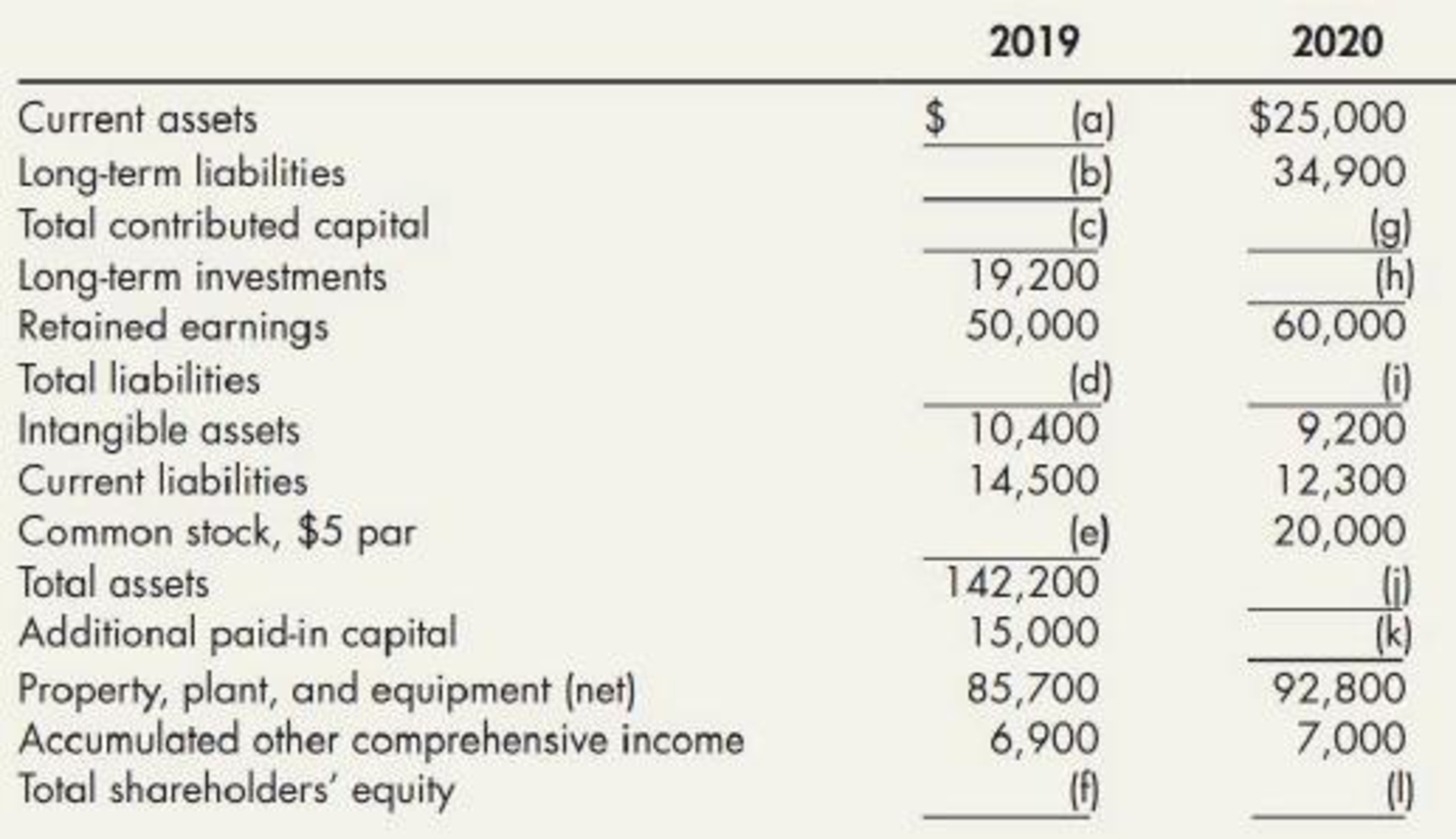

Additional information: The company did not issue any common stock during 2020.
Required:
Next Level Fill in the blanks labeled (a) through (l). All the necessary information is provided. (Hint: It is not necessary to calculate your answers in alphabetical order.)
Fill in the blanks labeled from (a) through (l).
Answer to Problem 8E
The balance sheet of D Company is prepared below:
| D Company | ||
| Balance Sheet | ||
| December 31 | ||
| 2019 | 2020 | |
| Current assets | 26,900 | 25,000 |
| Long-term investments | 19,200 | 22,200 |
| Property, plant and equipment (net) | 85,700 | 92,800 |
| Intangible assets | 10,400 | 9,200 |
| Total assets | $142,200 | $149,200 |
| Current liabilities | 14,500 | 12,300 |
| Long-term liabilities | 35,800 | 34,900 |
| Total liabilities | 50,300 | 47,200 |
| Common stock, $5 par | 20,000 | 20,000 |
| Additional paid-in capital | 15,000 | 15,000 |
| Total contributed capital | 35,000 | 35,000 |
| Retained earnings | 50,000 | 60,000 |
| Accumulated other comprehensive income | 6,900 | 7,000 |
| Total shareholders' equity | 91,900 | 102,000 |
| Total liabilities and shareholders' equity | $142,200 | $149,200 |
Table (1)
Explanation of Solution
Balance sheet: This financial statement reports a company’s resources (assets) and claims of creditors (liabilities) and stockholders (stockholders’ equity) over those resources. The resources of the company are assets which include money contributed by stockholders and creditors. Hence, the main elements of the balance sheet are assets, liabilities, and stockholders’ equity.
Calculate the amount of current assets (a) for 2019:
Hence, the amount of current assets for 2019 is $26,900.
Calculate the amount of common stock (e) for 2019:
Hence, the amount of common stock for 2019 is $20,000.
Note: As the company did not issue any common stock during 2020, the common stock of 2019 is equal to common stock of 2020.
Calculate the amount of total contributed capital (c) for 2019:
Hence, the amount of total contributed capital for 2019 is $35,000.
Calculate the amount of total stockholders’ equity (f) for 2019:
Hence, the amount of total stockholders’ equity for 2019 is $91,900.
Compute the amount of total liabilities (d) for 2019:
Hence, the amount of total liabilities for 2019 is $50,300.
Calculate the amount of long-term liabilities (b) for 2019:
Hence, the amount of long-term liabilities for 2019 is $35,800.
Calculate the amount of additional paid-in capital (k) for 2020:
Hence, the amount of additional paid in capital for 2020 is $15,000.
Note: As the company did not issue any common stock during 2020, the additional paid in capital of 2019 is equal to additional paid in capital of 2020.
Calculate the amount of total contributed capital (g) for 2020:
Hence, the amount of total contributed capital for 2020 is $35,000.
Calculate the amount of total stockholders’ equity (l) for 2020:
Hence, the amount of total stockholders’ equity for 2020 is $102,000.
Compute the amount of total liabilities (i) for 2020:
Hence, the amount of total liabilities for 2020 is $47,200.
Compute the amount of total assets (j) for 2020:
Hence, the amount of total assets for 2020 is $149,200.
Calculate the amount of long-term investments (h) for 2020:
Hence, the amount of long-term investments for 2020 is $22,200.
Want to see more full solutions like this?
Chapter 4 Solutions
EBK INTERMEDIATE ACCOUNTING: REPORTING
- Hendrix Corporation had annual sales of $75 million, which occurred evenly throughout the 365 days of the year. Its accounts receivable balance averaged $3 million. How long, on average, does it take the firm to collect on its sales? Answerarrow_forwardKichi company had the following informationarrow_forwardWhat is the flexible budget net income?arrow_forward
- Hendrix Corporation had annual sales of $75 million, which occurred evenly throughout the 365 days of the year. Its accounts receivable balance averaged $3 million. How long, on average, does it take the firm to collect on its sales?arrow_forwardWhat was the dollar amount of under allocated or overallocated manufacturing overhead ?arrow_forward5 POINTSarrow_forward
- False Value Hardware began 2013 with a credit balance of $31,900 in the allowance for sales returns account. Sales and cash collections from customers during the year were $680,000 and $640,000, respectively. False Value estimates that 5% of all sales will be returned. During 2013, customers returned merchandise for credit of $23,000 to their accounts. False Value's 2013 income statement would report net sales of: a. $657,000. b. $646,000. c. $648,100. d. $671,100.arrow_forwardCapitalisation methodarrow_forwardSubject: financial accountingarrow_forward
 Intermediate Accounting: Reporting And AnalysisAccountingISBN:9781337788281Author:James M. Wahlen, Jefferson P. Jones, Donald PagachPublisher:Cengage LearningPrinciples of Accounting Volume 1AccountingISBN:9781947172685Author:OpenStaxPublisher:OpenStax College
Intermediate Accounting: Reporting And AnalysisAccountingISBN:9781337788281Author:James M. Wahlen, Jefferson P. Jones, Donald PagachPublisher:Cengage LearningPrinciples of Accounting Volume 1AccountingISBN:9781947172685Author:OpenStaxPublisher:OpenStax College

